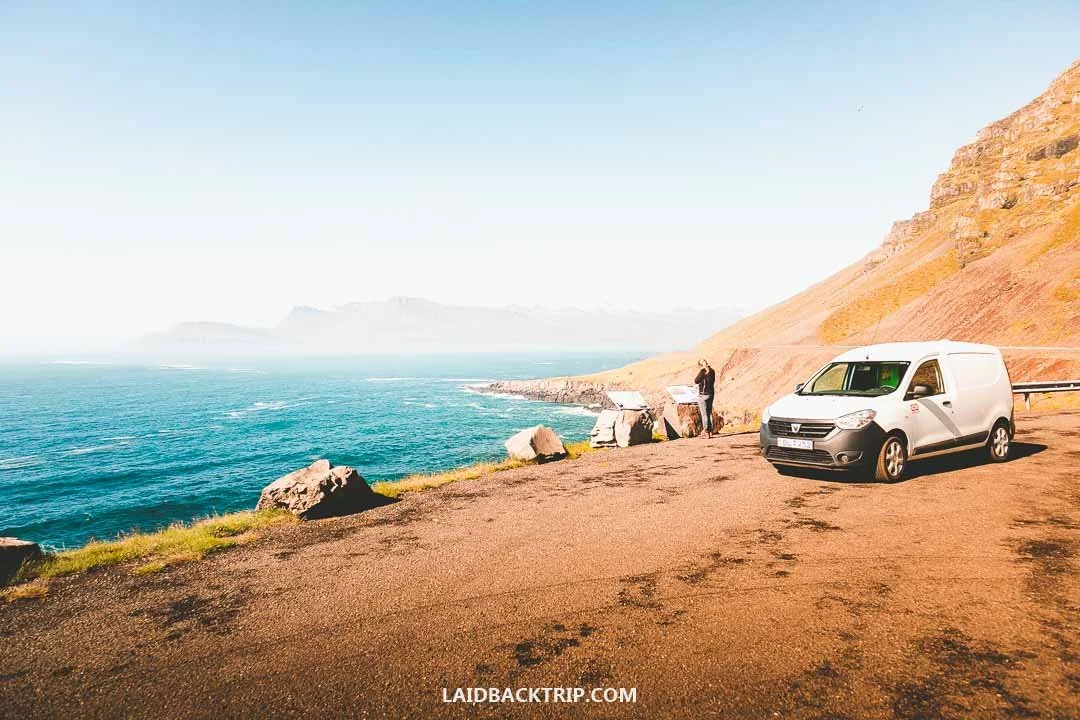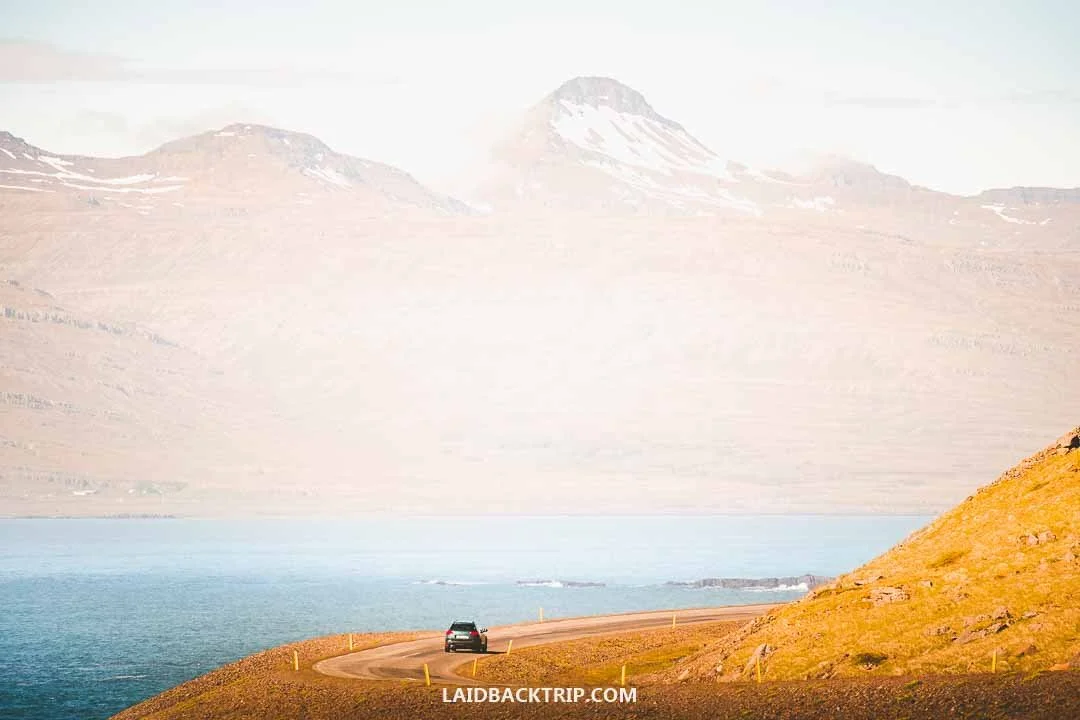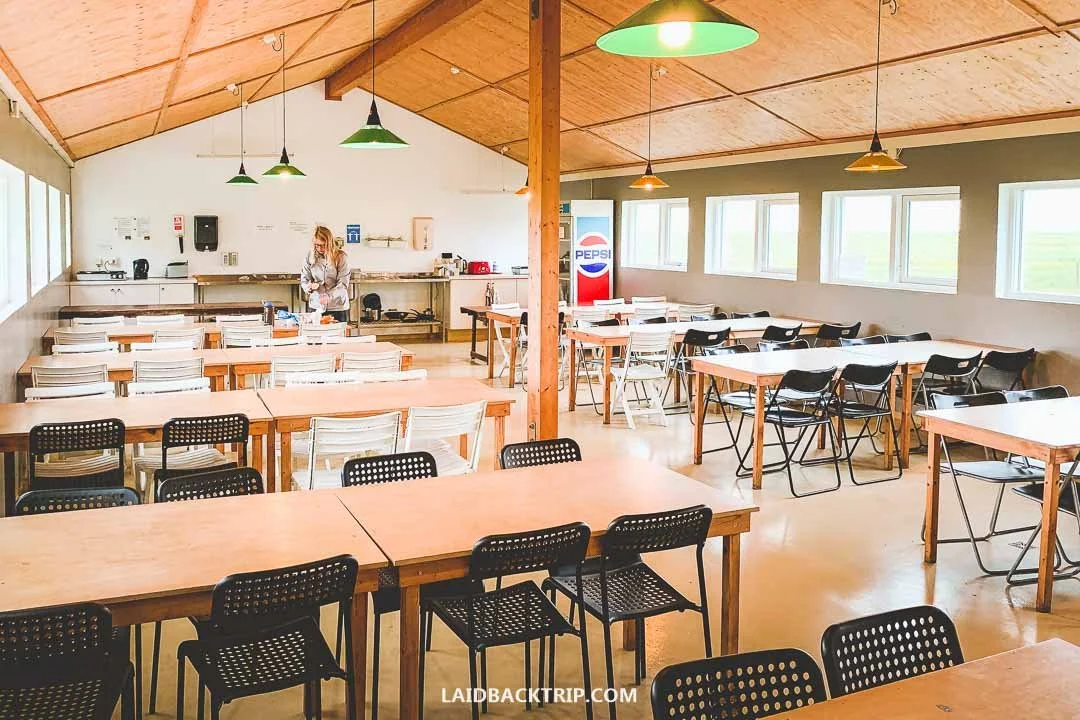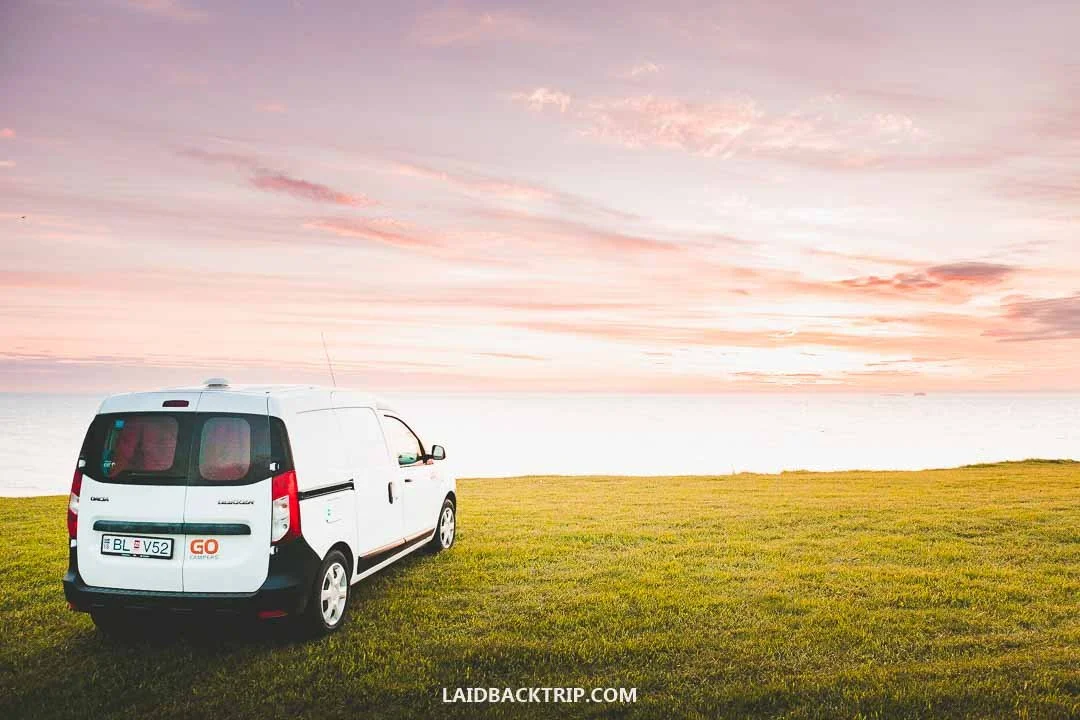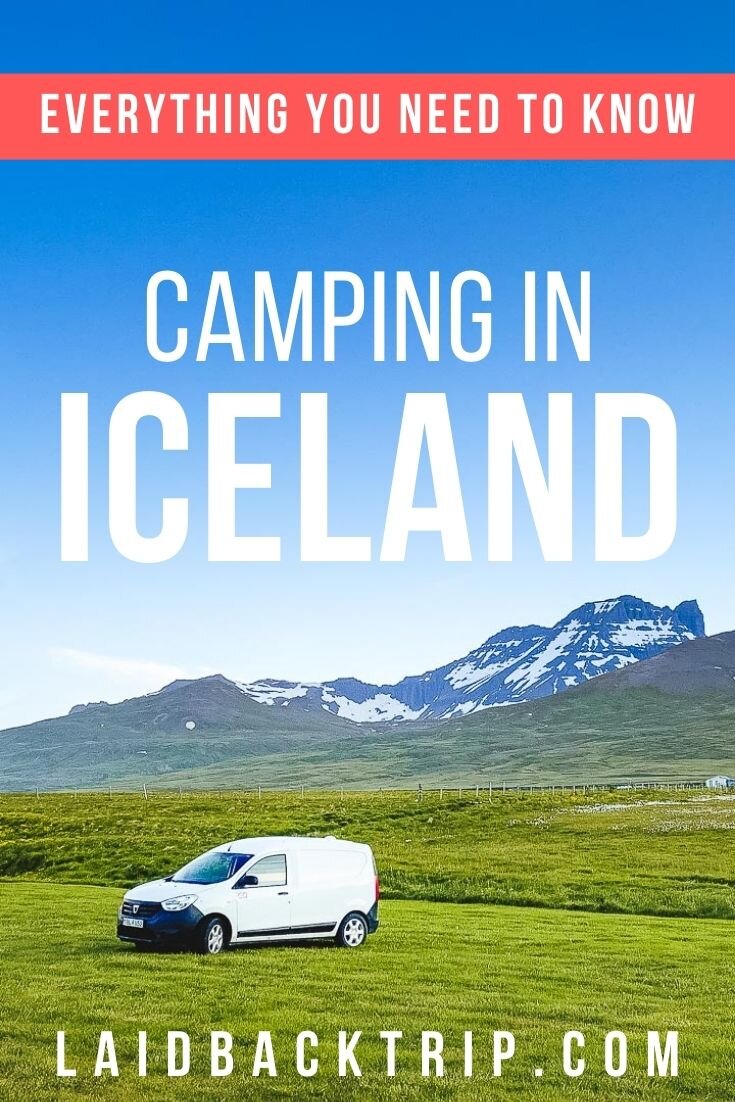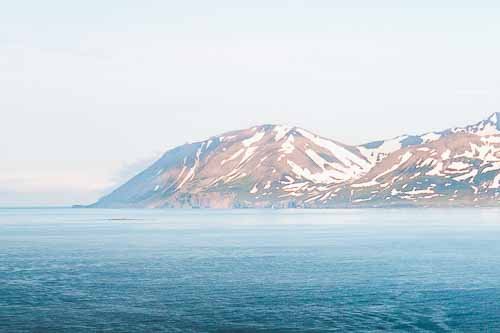A Guide to Camping in Iceland
Camping in Iceland is the ultimate experience, whether you sleep in a tent or campervan. Our Iceland camping travel guide covers everything you need to know, from camping fees, tips on the best campgrounds in Iceland, to whether you need to book ahead.
There's probably no better way to connect with nature than camping in Iceland.
Imagine spending all day outdoors admiring waterfalls, watching puffins, walking on black sand beaches, or overlooking the rough sea from high cliffs.
But when the evening comes, it does not end, you need to build a tent or prepare your campervan for the night, and you'll go to bed with incredible scenery in front of your eyes.
Sure, some of you might object that you can get a similar experience when you book a room in a hotel with a view.
Even though we see where this point comes from, we could not disagree more.
Camping in Iceland is an absolutely unique experience.
Even though it is sometimes challenging, not that comfortable, and at times even extreme because of the rough weather on the island, nature is still within reach.
Every cloud has a silver lining, and we are pretty sure that thanks to sleeping at campgrounds, you'll have fond memories of your entire Iceland trip, and you'll never forget this adventure.
Before you start planning your Iceland itinerary, it is necessary to answer a few questions, and one of the most important ones is where you are going to sleep and how you will get around.
In our opinion, camping in Iceland is awesome, but we realize it is not for everyone (more about it later).
That's why you should really think it through as your trip can turn perfect or miserable depending on your choice.
This Iceland camping travel guide is for those of you who think that camping in Iceland might be the best way to explore the country and think about it as part of the experience.
We share everything you should know about camping in Iceland before you go as we experienced it ourselves and know how important it is to be well-prepared for the journey.
From what to expect, how much things cost, how to save money to more detailed topics such as if you need to make a reservation in advance or where to find the best campground, we've got you covered.
Camping in Iceland, the same as tourism, has been lately booming in this country, and many things have changed.
Nevertheless, thanks to our recent visit, we have the most up-to-date information.
Different Ways to Camp in Iceland
Camping in Iceland has many forms. The most common ways of camping are sleeping in a rental car, campervan/motorhome, or a tent.
Sleeping in a Car
To be honest, we would rule out the option of sleeping in a car in Iceland.
Unless you like suffering, we think it is uncomfortable and not worth the effort.
Sleeping in a Tent
That leaves us with a tent or campervan.
Technically, it is the same as you are going to sleep in similar campsites, and all the rules will apply for either option.
What will be different is the entire experience and camping equipment you will need.
If you travel on a tight budget, one of the money-saving tips is rent a car and sleeping in a tent.
No matter how easy that sounds, it is necessary to realize that the weather in Iceland can be extreme even in the summer, and tent camping might be challenging.
We would not recommend tent camping for the first-time campers ever and outside the summer season.
Campervan
We have opted for sleeping in a campervan and could not be happier.
There is a large selection of campervans available in Iceland.
From the small basic ones to luxurious motorhomes, it's easy to choose the right one for you.
It all depends on your Iceland travel budget, the level of comfort you require, and how much space you need.
For more information, read our more detailed post on how to choose the best campervan in Iceland.
The choice of a campervan is really individual. We would only recommend you book a campervan with a heater between October and April.
Tips and Things to Know
Camping in Iceland is quite specific. Therefore, there are many things the first-time traveler to this country needs to know.
Of course, every previous camping experience is valuable and makes this one easier.
We slept in a really small campervan for a year in New Zealand and traveled the same way in the Canadian Rockies, Australia, or U.S. Northwest, so we could imagine what the experience would be like.
Still, there were a few things we learned about camping in Iceland that apply only to this country, and this is the reason why we created this separate blog post.
Here's everything you need to know, but if there is one thing we should share with you first-hand, it is the simple one: go for it.
Camping in Iceland is Not for Everyone
We do not want to discourage you from camping in Iceland. That's certainly not our intention.
On the other hand, we want you to enjoy your Iceland road trip as much as possible. Therefore it is necessary to say that camping is not for everyone.
If you know from previous trips that you need at least similar comfort on the road you have at home, you should not push it too hard.
There's nothing bad about it.
On the other hand, it's never late to choose a different travel style, and who knows, you might start loving it.
Same as we will never be luxury travelers as we cannot appreciate certain things (even though occasional treats never hurt anyone), many people might be disappointed with camping.
Is Camping Right for You?
Rule number one is to set your expectations right.
Facilities at the campground are often basic (and in high season, you have to believe they will be clean), and you might need to wait for your shower and bathroom time in a line.
It's been said a lot about weather conditions in Iceland.
Weather on this island is unpredictable, and building a tent or trying to cook in the wind and rain several days in a row can dampen the mood.
And some places such as South Coast are notorious for bad weather.
Expectations vs. Reality
Can you imagine yourself packing food and cooking equipment in the rain and running to a communal kitchen?
Do you have the patience to build a tent when the gusts of wind want you to fail?
These are only a few scenarios that you are very likely to experience during your road trip.
These are the memories that are great after the trip, but it can sometimes be annoying to deal with at that very moment.
Beginners Tips
We had great training from living in a campervan for more than a year; therefore, we knew the perks but also the lows of camping.
It would be great if you had an opportunity to spend at least a couple of nights camping outdoors before you set for your Iceland adventure.
Or, if you are not sure how you will handle it but want to get the camping-like experience anyway, the best alternative is renting the big motorhome that makes everything much easier.
You basically do not have to leave the motorhome, and even though in that case we think you do not have to go camping, it is certainly an option.
If you are now certain that camping is the best alternative for you, keep on reading.
Down below, we are going to answer the most common questions you might have before setting off.
Wild Camping Is Prohibited
Iceland has a really small population, about 360.000, so imagine what it must have been like when the country became over-popular with tourists.
All of a sudden, millions of people decided to visit the country.
Until then, things that were completely acceptable started bothering locals (quite understandably).
It is a difference when someone camp on your property every now and then or if it becomes a norm and your privately owned land becomes popular with tens of people every day.
Moreover, when the place does not have any facilities whatsoever.
No Wild Camping
Therefore, since 2015 it has been impossible to camp wherever you decide to stop, and it is necessary to find a designated campground every night.
Even though the idea of pitching a tent on an abandoned meadow somewhere in the Westfjords or Snaefellsnes Peninsula sounds romantic, this new law protects both locals, their properties, but also nature.
Wild Camping is Illegal
Yes, you hear it right. Wild camping in Iceland is illegal.
When driving around Iceland, you will soon notice that every single parking lot has a sign that overnight camping or even parking overnight is prohibited.
We kindly ask you to follow this rule.
Campgrounds in Iceland are plentiful, cheap, the network is really great, and you'll find at least one camp in every small village or settlement.
And by obeying this simple rule, you pay respect to this beautiful country that lets you freely explore its natural and cultural gems.
Free Camping
The only time you can free camp in Iceland is in an emergency situation.
But please, don't be one of those who abuse this rule. It's really not cool. Emergency means emergency.
Find a Campground
To search campgrounds for the night, we used official brochures, Google Maps, Maps.me or an online interactive campsites map that shows both seasonal and permanent campgrounds.
Once again, it's easy to find a designated campground in Iceland, so there's no need to break the law.
Camping Card
If you are looking for Iceland camping tips that could help keep your Iceland Budget at bay, consider purchasing an Iceland Camping Card.
This card is quite popular, but you must do some planning before purchasing one.
How Does it Work?
When you purchase the Iceland camping card for 159 EUR, it gives you access to 41 campsites in Iceland.
The card is valid for 28 nights, and two adults with up to four children can use it.
As some of the campsites are only seasonal, it is possible to use this card fully between May 15 and September 15.
To ensure that this card pays off, you should know how many nights you are going to sleep in Iceland.
And it also requires planning the trip in advance to make sure that campgrounds included in the promotion are close to the sites you want to visit.
As we reserved our trip to Iceland last minute and had no idea where we would end up every night, we did not purchase this card.
On the other hand, if we had been more organized, it would have saved us a few bucks.
Where to Buy
It is possible to purchase a camping card on the official website, in convenient stores, post offices, or campsites that are included in the program.
Most rental car companies promote them as well.
How Much Does it Cost to Camp in Iceland
In comparison with staying in hotels, camping in Iceland is extremely cheap.
It is also one of the reasons why is this way of exploring Iceland increasingly popular.
Sure, a campervan is more expensive than a rental car, but the initial cost will pay off later.
Camping Fees
So what are the camping fees in Iceland?
Every campground is different, but we paid between 10 and 15 USD per person per night, and you surely won't find a hotel for this amount of money.
Usually, the shower was included. If we recall correctly, we had to pay a bit more for taking a shower only in two instances.
Iceland is, in general, an expensive country, and we know that 30 USD (in case you travel as a couple) can seem quite high for a campsite.
But believe us, it is significantly less than what would you pay for a hotel room, especially in the summer season.
The good news is that even at the smallest and most abandoned campground was possible to pay by credit card, that only proved to us how modern Iceland is.
Reservations
One of the perks of camping in Iceland is the fact that you do not need to book anything in advance; it is not even possible.
Camping in Iceland works on a first-come, first-served basis.
For example, that’s a very different approach from the Canadian Rockies' camping reservations system, where you need to book the best campsites several months in advance.
Most of the campgrounds in Iceland are large open fields that fit hundreds of cars or tents.
It is a real advantage when we compare it with other types of accommodation that are often expensive and booked out several months in advance.
Plus, your itinerary can be a bit more flexible, thanks to it.
Despite the fact that the campground system basically works on a first-come, first-served basis, we've probably never heard about a situation in which a traveler would not be able to find a space at a campground.
The reason is that the most popular campsites close to the top attractions are usually also huge.
Some Campsites Are Seasonal
Camping and weather often go hand in hand. Winter in Iceland is cold, dark but also less crowded.
Add the magical atmosphere of the places such as Diamond Circle or Golden Circle, and you might be one of those travelers who would like to experience it.
If you plan to travel outside the peak season, approximately between October and April, and you do not want to give up on camping, it is necessary to know that not all of the campgrounds in Iceland are open all year round.
Therefore, you have to plan your trip accordingly.
Actually, the majority of campsites are only seasonal because a large percentage of all visitors to Iceland travel during May and September, with an absolute peak between June and August.
It goes without saying that you must do more thorough research when you plan on camping outside the summer season in terms of weather, the gear you might need, and overall what to expect.
By the way, the link we've shared with you earlier in this post also includes a map of seasonal campgrounds in Iceland.
Facilities
What facilities can you expect at campgrounds in Iceland?
Every campsite is a bit different, so if you require specific services such as laundry or electric hook, you must search for additional information whether it is available.
Our requirements were pretty low; all we needed was a hot shower, clean bathroom, and a good location.
Every campsite where we slept had a hot shower (usually included, two times it was for an additional 400 ISK per person), flushing toilets, and a cooking shelter.
Most of the kitchens were equipped with an electric stove and sink, occasionally a kettle, but we needed to use our own pots, dishes, and cutleries.
It is possible to charge your electronics in the campsites, but we had a power inverter in our car, so we could charge not only phones but even the camera, which we found very convenient.
All of the campsites were exceptionally clean.
The only disadvantage we noticed was that the number of showers and toilets was inadequate for the number of travelers, which might be a problem in the peak season.
On the other hand, privacy during hygiene is one of those things that lower the comfort when you opt for sleeping at campgrounds, and it is something you must be ok with.
What Camping Gear Do You Need
What equipment do you need to make the camping in the Land of Ice and Fire as comfortable as possible?
If you plan to sleep in a tent, it is essential to have a good windproof and waterproof tent.
Jokes aside, in case you underestimate your research, Iceland's weather might show you its darker side.
Then it would help if you had a sleeping bag and inflatable mat. We also like to bring a cocoon and inflatable pillows.
Although every phone nowadays has a flashlight, we recommend having a headlamp.
You can either bring your own equipment, rent it, or even buy it in Iceland, but it would be very costly.
If you prefer camping in a campervan, you need everything mentioned above except for a tent.
That's being said, most of the campervans come with a mattress, pillows, and our campervan rental even included sleeping bags.
So we did not have to bring our own, which was a big help.
As the packing list for enjoying Iceland outside can be very complex, feel free to read our Iceland packing guide.
Campfires Are Prohibited
Many travelers cannot imagine camping without campfires, so it comes as a shock that campfires in Iceland are prohibited.
There are a few exceptions, but the rule of thumb is simple - you cannot light a campfire in the campground.
There are several reasons behind it.
The most important one is the lack of wood and also the fragile environment.
And, of course, the large number of visitors who could cause a disaster if they disobeyed the rule and something went wrong.
Drinking Water
As soon as we landed, we were greeted by several marketing ads on the way to the airport security gates.
Some of them were promoting the unreal natural beauty of Iceland, such as Kirkjufellsfoss, or other exceptional experiences such as Blue Lagoon.
One of the ads was a bit different, though.
There was an image of a sparkling icy cold blue water with a simple slogan Drinks are on us!
Being a responsible traveler is a hot topic right now, and drinking tap water is one of the easiest steps that anyone can take.
Every time we think about reducing plastic waste while traveling, drinking tap water is high on our list of priorities as it is so simple yet effective.
And we know that there are countries where you might feel reluctant to drink water directly from the tap, but Iceland is definitely not one of them.
Yes, Iceland has clean water.
This option is always welcomed for us, who drink tap water every day back home. The only thing you need is your own bottle.
We brought our own water bottles that we use all the time and drank the tap water whenever it was possible.
Make sure to drink the cold tap water; the hot tap water quite often smells like sulfur as it has a geothermal origin.
And if you are not all that thrilled about the environment, think about your wallet. The consumption of bottled water is not economical at all.
Cook Your Own Food
Camping comes hand in hand with cooking, and this fact is truer than ever in Iceland.
Most importantly, it will save you a ton of money.
As we said before, the Land of Fire and Ice is not a budget-friendly country.
Although there are several ways to save money while traveling around Iceland, cooking is one of the best of them, and it is quite natural to cook your own food at campgrounds.
Eating out is super expensive in Iceland, and as we consider ourselves budget travelers, going into the restaurant was out of the question.
Depending on your travel style, make sure you have all the cooking equipment you need.
We traveled in a campervan, and most of the cookware was included in the reservation.
Cooking Gear
The only thing we brought extra was our trusty folding knife, which is the second one we lost (the first one we left in Manizales, Colombia).
When you rent a regular car and sleep in the tent, you might need a few extra things such as a cooking set, stove & gas cans, and stove screen.
These things come in very handy also for multi-day hikes.
Of course, you can rent all this stuff in Reykjavik, though we believe it's better to bring your own.
Plus, these things are built like tanks and will last years. We still have our own cooking set we bought years ago when we lived in New Zealand.
You can indeed park your car in the campground and head to a restaurant at the end of the day, though you will miss a big part of the camping experience.
Cooking in your campervan, in the shared kitchens, parking lots, or rest areas creates great travel memories and stories.
And last travel tip, you can always meet some new friends in the common areas.
Travel Insurance
We never leave home without travel insurance that was designed to cover our expenses if something goes wrong during the trip.
Travel insurance protects against theft, flight delays, injury, illness, cancellations, and much more.
World Nomads provides travel insurance for travelers to cover their trip essentials, including sports and adventure activities.
SafetyWing is affordable travel insurance for backpackers, long-term travelers, and digital nomads.
Travel smarter and safer!
Weather Can Affect Your Experience
Now it is time to look closer at camping in different seasons.
Weather in Iceland can change several times a day, and even summer days can be cold and rainy.
Still, it is the best time for camping in this country.
We would say that camping in Iceland is doable between May and September. It might be a bit tougher during April and October.
The winter months between November and March are, in our opinion, not suitable for camping unless you are experienced and have good equipment that would keep you warm.
Packing Tips
Weather can really affect your Iceland camping experience, either positively or negatively, so you need to pack right no matter what season you eventually opt for.
For more detailed information on what to pack, check out our Iceland Summer Packing List, which actually does not differ that much from things we would pack for other seasons.
Pack many layers - functional t-shirts, leggings to stay warm, fleece jacket, down jacket, rain poncho, rain jacket, and extra clothes in case you do not have an opportunity to dry wet clothes straight away.
A must-have thing for camping in the summer is a sleep mask because of the midnight sun.
If you don't know what exactly midnight sun is, check out this article - Things to Know About Iceland Before You Go.
Travel Resources
Here you can find links to all the travel resources we use and which you might find helpful when planning your next holiday.
Accommodation: When looking for accommodation, we usually search hotels via Booking.com or Hostelworld.
Tours: Although we love to travel independently, some places are better to visit with a guided tour.
We prefer GetYourGuide for its easy-to-use interface and solid reputation. Another great alternative is Viator.
Rental Cars: When going on a road trip, we always use Rentalcars.com, a reliable site for booking a rental car in advance.
Flight Tickets: When looking for flight tickets, you can search Skyscanner to find the best price.
Travel Insurance: World Nomads and SafetyWing cover against risks of travel.

